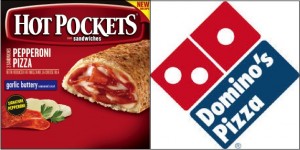 It still may not be the best of pizza, but it was once among the worst of pizza.
It still may not be the best of pizza, but it was once among the worst of pizza.
In 2009, besieged falling sales and diminished margins resulting from recession, price wars and brutal competition from rivals Pizza Hut and Papa John’s, Domino’s took a long hard look at itself and owned up to what the rest of the world had long realized. Its pizza was awful.
A public relations blitz by Nestle for its Hot Pockets brand generated lots of press last week, including an article in the Los Angeles Times titled “Hot Pockets Wants To Be Cool Among Foodies” that described a similar epiphany.
“The brand wants to ditch its decades-long reputation as a thawed-out brick of dough with machine-cut blocks of lunch meat… To do it, the company is stuffing its dozens of Hot Pockets varieties with more upscale ingredients…”
Two old brands facing similar problems. Both were relatively cheap, convenient, functional “gut-fill” foods in highly competitive categories that were losing ground in a market that was evolving toward higher quality choices.
The business strategy was obvious. The tried and true “new and improved” product approach would provide a reason for lapsed users to come back, for infrequent users to buy more often, and for new users to try the brand for the first time.
However, the two different approaches taken by these brands in bringing this classic packaged goods “Marketing 101” strategy to life are striking. One is straightforward, smart, honest and grounded in reality. The other is a paint-by-numbers, tone-deaf marketing fantasy.
Can you already tell which one is which? If the L.A. Times headline about Hot Pockets aspiring to “coolness” didn’t tip you off, then this line from the article should be all you need:
“(Nestle) …wants the microwaveable turnovers to be taken seriously as a sandwich with street cred among gastronomes.”
Let’s forget for a moment that “street cred” is probably not what “gastronomes” are looking for. But Gourmet Hot Pockets? Really?
The article goes on to say, “the hope is to better appeal to the so-called millennial generation of young foodies while escaping from a recent revenue rut…To do it, the company is stuffing its dozens of Hot Pockets varieties with more upscale ingredients, including premium meats such as shaved hickory ham and slow-cooked Angus beef. The two new types of crust include a buttery garlic option and a crispy version akin to a savory croissant.”
The problem here should be obvious. You don’t go from garbage to gourmet overnight. They could put Kobe Beef and free range organic chicken in there, but it would still be Hot Pockets. Junk food from the microwave.
Adding insult to injury, the new commercial for Hot Pockets tries to make the product sexy. Oh, it’s got attitude, baby! A beautiful young woman, music and narration paying homage to Barry White – isn’t it a perfect fit? Is there anything sexier than the way you feel after wolfing down a nice helping of greasy Hot Pockets?
This is a case of a good strategy gone bad, marketing people looking at trends and trying to check the boxes without thinking too deeply. Yes, Millennials are making better food choices, but that doesn’t mean that they’re craving “gourmet” Hot Pockets. In fact, it’s just the opposite. Younger people are running away from Hot Pockets and similar products for more authentic “good food.” Perhaps there is now Angus beef and a new crispy, “savory croissant” crust but at the end of the day it’s still highly processed, microwave fare.
Perhaps better ingredients could have inspired a “taste it again” approach, or possibly some kind of messaging around how the brand is evolving for it’s audience and the times. Even better, an ironic approach, something totally self-aware and honest that celebrates Hot Pockets as the crave-able, convenient junk food it is.
In either case, it would certainly have been possible to change perceptions from “bad” to “decent.” But Hot Pockets, of all brands, has no business moving away from its essence and then expecting people – especially the discriminating food lovers Nestle claims it wants to target – to believe that it’s now great food for “gastronomes.”
Domino’s, on the other hand, did everything right. They publicly admitted that people thought of their food as “cardboard.” And they took to the airwaves with a big mea culpa, a plea for consumers to try the new recipe with a money back guarantee to back it up. They were humble, open and honest. No smoke and mirrors, no sexy ads, and no unrealistic promises.
Had Domino’s launched the very same, new and improved pizza recipe positioned as an alternative to CPK or Wolfgang Puck, the effort would have fizzled. It was still Domino’s, just a much better version of it.
Pizza consumers responded very positively and the company continues to enjoy higher sales based on the product re-launch. Hot Pockets? Time will tell. But don’t be surprised to read about yet another “re-launch” a year from now.



